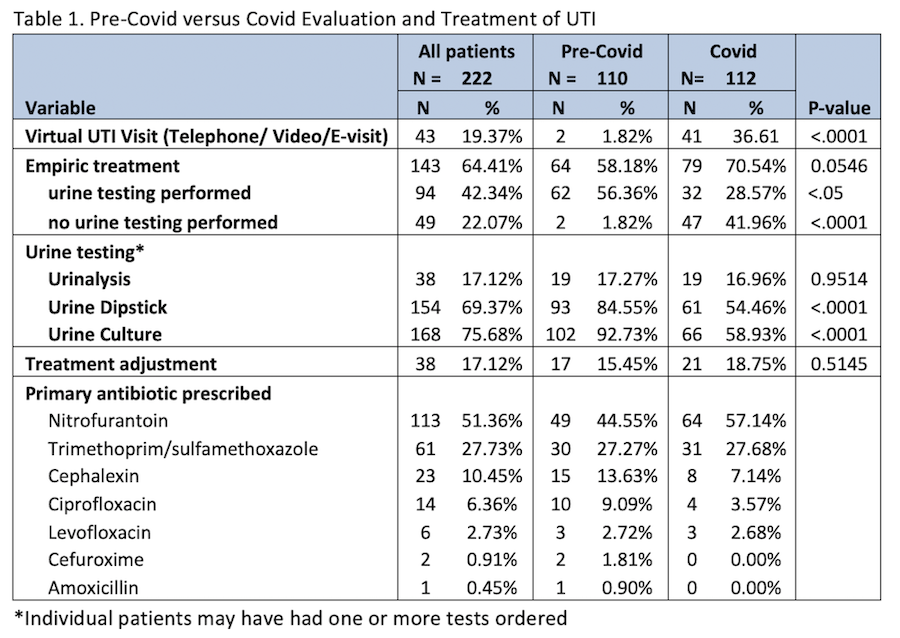Back
Poster, Podium & Video Sessions
MP02: Infections/Inflammation/Cystic Disease of the Genitourinary Tract: Kidney & Bladder I
MP02-07: The Impact of Covid-19 and Telemedicine on Empiric UTI Treatment in Women
Friday, May 13, 2022
7:00 AM – 8:15 AM
Location: Room 225
Madeline Epsten*, Jennifer Ferraro, Fareesa Khan, Cynthia Brincat, Kristin Jacobs, Chicago, IL
- ME
Poster Presenter(s)
Introduction: Urinary tract infection (UTI), one of the most common reasons women seek acute care, is responsible for 15% of all community-prescribed antibiotics. The effects of the pandemic and telemedicine on UTI treatment are largely unknown. Here, we evaluated the impact of Covid-19 and telemedicine on empiric UTI treatment in women. We hypothesized that increased use of telemedicine during the pandemic would increase the rate of empiric UTI treatment.
Methods: This is a retrospective cohort study of treatment patterns of female patients aged 18-65 using ICD-10 codes for acute cystitis with (N30.00) and without (N30.01) hematuria during the first 6 months of the pandemic (March 2020 – August 2020) versus the 6 months preceding the pandemic (September 2019 – February 2020). Our primary outcome was presence of empiric antibiotic treatment, defined by treatment based on clinical picture with or without pending urine testing. Secondary analysis included determining which antibiotics were most commonly prescribed and treatment adjustment. To reach 80% power to detect a 10% difference with p=0.05, we included 222 patients. Exclusion criteria included inpatient encounter, long-term facility residence, urinary procedure in last 2 weeks, previous UTI treatment within 30 days.
Results: The average age of participants was 42 years. Fifty-two percent were white, 23% Black, and 23% Hispanic. No demographic differences existed between cohorts. During the pandemic, 36.6% of UTI encounters were conducted via telemedicine, compared to 1.5% pre-pandemic (p <.0001). The rate of empiric treatment increased from 58.2% pre-pandemic to 70.5% during the pandemic (p=.055). The rate of treatment based on clinical picture with no pending urine testing was significantly higher during the pandemic (p <.0001). Nitrofurantoin or trimethoprim/sulfamethoxazole was used in 79% of patients prescribed an antibiotic. The overall rate of treatment adjustment was 17.1%; there was no significant difference by time period.
Conclusions: Covid-19 dramatically increased telemedicine utilization by women with UTI symptoms. Empiric treatment approached significance and confirmatory urine testing was done significantly less during the pandemic. Given the importance of antibiotic stewardship, it is important to further characterize telemedicine’s impact on treatment of this common condition.
Source of Funding: None

Methods: This is a retrospective cohort study of treatment patterns of female patients aged 18-65 using ICD-10 codes for acute cystitis with (N30.00) and without (N30.01) hematuria during the first 6 months of the pandemic (March 2020 – August 2020) versus the 6 months preceding the pandemic (September 2019 – February 2020). Our primary outcome was presence of empiric antibiotic treatment, defined by treatment based on clinical picture with or without pending urine testing. Secondary analysis included determining which antibiotics were most commonly prescribed and treatment adjustment. To reach 80% power to detect a 10% difference with p=0.05, we included 222 patients. Exclusion criteria included inpatient encounter, long-term facility residence, urinary procedure in last 2 weeks, previous UTI treatment within 30 days.
Results: The average age of participants was 42 years. Fifty-two percent were white, 23% Black, and 23% Hispanic. No demographic differences existed between cohorts. During the pandemic, 36.6% of UTI encounters were conducted via telemedicine, compared to 1.5% pre-pandemic (p <.0001). The rate of empiric treatment increased from 58.2% pre-pandemic to 70.5% during the pandemic (p=.055). The rate of treatment based on clinical picture with no pending urine testing was significantly higher during the pandemic (p <.0001). Nitrofurantoin or trimethoprim/sulfamethoxazole was used in 79% of patients prescribed an antibiotic. The overall rate of treatment adjustment was 17.1%; there was no significant difference by time period.
Conclusions: Covid-19 dramatically increased telemedicine utilization by women with UTI symptoms. Empiric treatment approached significance and confirmatory urine testing was done significantly less during the pandemic. Given the importance of antibiotic stewardship, it is important to further characterize telemedicine’s impact on treatment of this common condition.
Source of Funding: None


.jpg)
.jpg)